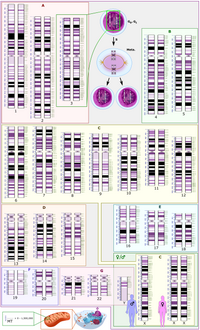
Photo from wikipedia
The Nguni cattle breed predominates South Africa and is endowed with traits favourable against environmental stressors such as heat stress and resistance to diseases. Interventions to improve production have led… Click to show full abstract
The Nguni cattle breed predominates South Africa and is endowed with traits favourable against environmental stressors such as heat stress and resistance to diseases. Interventions to improve production have led to the erosion of the genetic integrity of local breeds and the introduction of exotic breeds has proved ineffective as they fail to perform well due to different climatic conditions and production systems. In this study, the genetic structure and genetic lineage of Nguni crossbreds from 6 populations were assessed using the mitochondrial cytochrome b gene. Twelve polymorphic sites were detected resulting in 11 haplotypes with haplotype and nucleotide diversities of 0.550 ± 0.135 and 0.0019 ± 0.0011, respectively. Only 2 of the 6 populations displayed recent population expansion events, whereas the majority adhered to neutral evolution. The basal haplotype contained approximately 60% of the studied populations and there were four unique haplotypes that were revealed. A possible Nguni descript haplotype was uncovered, and this haplotype was found in all populations but was however devoid of individuals from around the world. The genetic structure of the populations was rather low (average pairwise FST = 0.066 and Slatkins FST = 0.094), and approximately 96% of the total genetic variation was accounted for by differences within populations. Phylogenetic analyses supported the clustering of all the samples within the Bos taurus clade and no Bos indicus haplotype was detected. Furthermore, no intermediate haplotype of taurine and indicine was detected. Overall, the maternal lineage of the crossbreds points to a taurine origin and the low genetic diversity depicts the retention of the Nguni genetic pool and possibly its superior adaptive traits.
Journal Title: Tropical Animal Health and Production
Year Published: 2020
Link to full text (if available)
Share on Social Media: Sign Up to like & get
recommendations!